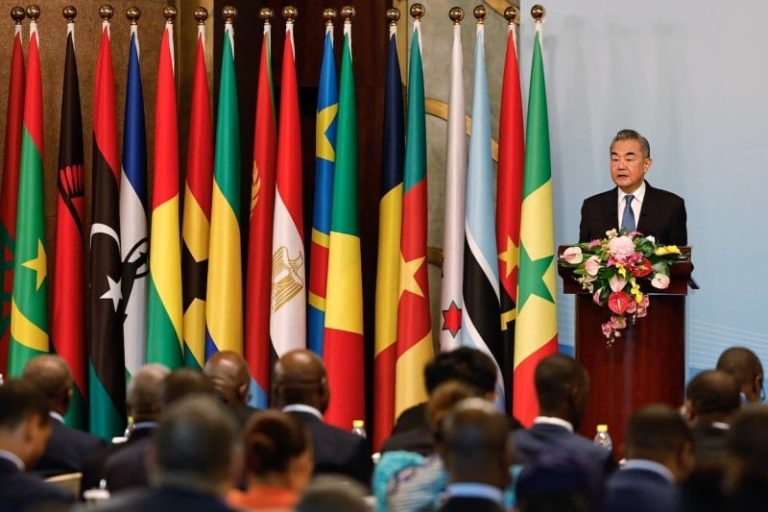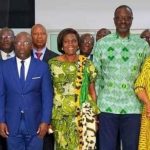China’s Conflict Resolution and Mediation Approach in Mali
China’s Foreign Minister Wang Yi delivers a speech at the ministerial conference of the 2024 Summit of the Forum on China-Africa Cooperation in Beijing, on Sept. 3.
China takes a cautious approach to conflict mediation in the Sahel, where there are high political risks and lower economic/security interests.
On April 21, 2022, President Xi Jinping delivered a speech at the opening ceremony of the Boao Forum for the Asia Annual Conference, proposing the Global Security Initiative for the first time. Providing more details about the initiative, Foreign Minister Wang Yi explained that the initiative is “inspired by the diplomatic tradition and wisdom with unique Chinese characteristics” to maintain world peace and tranquility. As evidenced by the initiative, China’s involvement in global security is evolving and growing. One of the main goals of this chapter is to unpack what Chinese wisdom and Chinese characteristics in conflict resolution entail and what are their unique strengths and weaknesses.
At first glance, China’s approach to conflict resolution is strategically ambiguous. Not having a well-defined or clearly spelled out doctrine or policy toward conflict resolution allows Beijing the flexibility to decide which conflicts or disputes are a priority and which are not. This chapter suggests that the likelihood of China’s involvement in dispute resolution is higher if two necessary conditions are met: 1) that the conflict is of urgent economic or security interest to Beijing (high economic and security interest gain), and 2) that there is relatively low risk diplomatically with regard to Western powers involved (low risk of entanglement with other powers). The second condition can help us understand Beijing’s reticence in being involved in conflict resolution in Nigeria despite Nigeria being China’s largest trading partner in the African continent. Furthermore, these two conditions—high gains and low risk—are necessary but not sufficient, as a basic condition is a political willingness and capability (from Beijing) to be involved in a given conflict resolution scenario.
In this way, it becomes immediately visible that countries in the Middle East, for instance, are more or less outside of this scope, given the high risk of being entangled not only with local actors but with the multitude of foreign powers present in the region and their diverging interests. In such a scenario, Beijing would calculate that the risks of intervening in conflict resolution (in a meaningful rather than symbolic way) outweigh the benefits. In the Horn of Africa, for instance, the urgency of economic and security interests is high, and risk of encroachment is relatively low, so we see more activity from Beijing in mediating conflicts in East Africa. It is this chapter’s contention that the climate in the Sahel (especially with the crisis in Mali) is more similar to the Middle East (low urgency in economic and security interests, with high political risk due to extensive foreign intervention) than it is to East Africa when it comes to China’s mediation behavior.
For this reason, Beijing had to be extra-creative, indirect, and practice mediation from afar in the Sahel region, since the amount of strategic Great Power game at play in the region is a deterrent for Beijing. In many ways, the Sahel region is an exceptional case when compared to the rest of Africa, which typically gets depicted in policy expert analyses in terms of a “power vacuum” that was left up to emerging powers such as China to fill. Such a “vacuum” does not exist in the case of the Sahel region given France’s strategic interest in the region and its overt (and paternalistic) sense of priority of intervention, European Union actors, U.S. Africa Command (AFRICOM), and Russia’s involvement, among other players. In light of such a complex picture of a cacophony of foreign interests in the region, Chinese officials have expressed their cautious approach. Many times over, Beijing signaled that its reticence toward a more involved engagement in Mali was due to being cautious so as to not alarm France with a heavy Chinese presence.
It is also the case that while the Sahel might be a rather exceptional region within Africa when it comes to China’s mediation practices, it is similar to other regions of the world where China has Belt and Road Initiative investment interests and Western powers have geostrategic interests or historic presence that remains on the political scene. In this way, learning about China’s mediation practices in the Sahel can help us understand its practices in many other places, including in the Middle East.
Therefore, this chapter asks why China’s approach to conflict resolution and mediation is proactive in some regions in the African continent and reticent in others. In this pursuit, the chapter develops as follows. The introductory section provides an overview of China’s views on conflict resolution from the perspective of noninterference policy. This section also introduces various conflict resolution tools and mechanisms that emerged as a response to the limitations of the noninterference principle. These include harmonious intervention, quasi-mediation diplomacy, special envoy diplomacy, and creative engagement. The second section identifies and expands on three drivers behind China’s interest in dispute resolution and mediation diplomacy in Africa. The third section focuses on the Sahel region with specific interest in examining China’s mediation approach in the Malian crisis. The fourth section analyzes the challenges and opportunities of China’s mediation approach in the Sahel and offers an assessment of what lessons we can learn about China’s mediation approach in the Middle East from studying the Sahel. A fifth section concludes the chapter.
Contours of China’s mediation in Africa: From noninterference to creative involvement
China’s policy towards the Sahel and in Africa more broadly is mostly based on its policy of noninterference in internal politics, which makes China a neutral player in conflict-zoned states. In 1954, after a meeting of Indian and Chinese officials, Zhou Enlai announced the five principles of peaceful coexistence. These five principles, which primarily center sovereignty and mutual noninterference, became a signature foreign policy characteristic of Chinese foreign policy conduct. Since then, for a variety of reasons, Chinese foreign policy had to gradually move away from a strict adherence to the principle of noninterference and embrace a more pragmatic approach. Often labeled noninterference “with Chinese characteristics,” this approach allows enough maneuvering for Chinese foreign policymakers to adapt to China’s growing presence globally both as an economic and as a political actor.
Moving away from a strict interpretation of the noninterference principle made way for a strategic ambiguity around China’s policy toward intervention. This has led scholars and policymakers to propose a multitude of concepts and theoretical frameworks to make sense of China’s future involvement in international disputes. Some of these include differentiating between interference, influence, and intervention. Others, like Huang and Shih, proposed “harmonious intervention” as a framework that can position China to maintain its core values of having long-term constructive relations with other countries while at the same time being able to adjust its foreign policy priorities.
Chinese scholar Wang Yizhou advanced “creative involvement” as a way to capture China’s pragmatic approach to and its more or less case-by-case evaluation of dispute resolution mechanisms, rather than one blanket policy of intervention vs. restraint. Far from advocating the use of force or seeking regime change in host countries, Wang proposes a flexible approach grounded in cooperation with regional actors whereby, in the event of Chinese involvement in conflict resolution, Beijing will ensure that there is international consensus in supporting China’s actions and that local and regional players welcome China’s participation in the process. Taking into account China’s reputation on the global scene as, ironically, simultaneously both a free-rider and a threat, Wang advocates that China plays first-mover advantage to its interest by proactively reaching out with creative involvement platforms that align with its strengths and interests. As a first-mover, or as Jesse Marks terms it, “conflict manager” in lieu of “conflict avoider,” China would be able to set the pace and tone of its creative involvement approach in international crises. This way, it would not be pressured to join intervention platforms that other actors have designed.
Marks further notes that from a Chinese government perspective, three modalities describe the rationale for Beijing to become a “conflict manager”: persuading peace, promoting talks, and mediation. These three modalities are predicated on the assumption that use of force or of power politics to impose a solution is a nonstarter for Beijing. Further making sense of Chinese approaches to conflict resolution, Sun and Zoubir propose “quasi-mediation,” explaining that “China reacts selectively and cautiously to different events according to what its policymakers consider to be of either vital or secondary interest.” This leads them to argue that this cautious approach where China participates but does not play a consequential role is a deliberate diplomacy that they dub quasi-mediation rather than a full mediation practice.
Sun and Zoubir define mediation as “third-party intervention in conflicts with non-coercive and neutral ways through peaceful management and behavior to address a conflict whose direct outcome is the transformation of bilateral relations into trilateral ones.” In peace research scholarship, other terminologies that are close to mediation include arbitration, consultation, and conciliation. However, as we have seen, Chinese approaches to these concepts tend to be unique and to diverge from these to some degree, especially in practice.
For example, whereas mediation diplomacy is typically a discreet mechanism of diplomacy, even in its discretion, an actor acting as the mediator typically plays a dominant role, trying to sway involved parties in the direction of peace talks. In contrast with this approach, in China’s quasi-diplomacy approach, the mediating actor is not the dominant actor seeking to explore leverage created through Guanxi but is merely a participating actor.
Burton, however, argues that “it does not appear that China is carrying out quasi-mediation in any of the three Middle East conflicts [Libya, Syria, and Yemen].” Instead, for him, China’s approach in the region is more appropriately labeled as a “wait and see” approach. For Sun and Zoubir, however, taking seriously China’s emphasis on the primacy of dialogue and peace talks over the use of violence or dominant actor behavior leads scholars to see Beijing’s subtle and discrete practices as part of a different model of mediation. Indeed, owing to the deep conviction that dialogue is the best path to peace, one meditation mechanism that China initiated to respond to the Darfur conflict was the special envoys mechanism. In 2007, Ambassador Liu Guijin made several visits to southern Sudan and neighboring African countries, as well as to Europe. Indeed, Western interpretations of what conflict mediation is and what it looks like in practice diverge from Chinese approaches in significant ways. The next section unpacks the drivers behind China’s involvement in mediation diplomacy in order to further clarify the difference and similarities.
Drivers of China’s involvement in mediation diplomacy
Several drivers can explain China’s increasing involvement in mediation efforts globally. Depending on the case at hand, a mix of drivers can be identified along the axis of ideologically to necessity motivated. Three drivers are specifically identified: Commercial, political, and reputational. These three categories are not mutually exclusive. More often than not, two or more drivers converge in one particular case.
Commercial: Where Chinese commercial interests are high, the likelihood of Beijing being involved in mediation is high. We have seen this in the Darfur conflict, where China’s oil interests and energy security were at the core of its motivation to engage in mediation. It is also observable in Afghanistan, Iran, and Korea. Additionally, the Belt and Road initiative has an added incentive for China to be more involved with mediation.
In comparison with other regions of Africa, China’s commercial interests in the Sahel countries are rather limited. In Niger, China has energy and mining interests that could at some point grow more significantly; in Mali, trade and investments by Chinese enterprises are not negligible; and in Chad and Burkina Faso (which only normalized relations with Beijing a few years ago), energy investments and trade relations have yet to bloom in significant ways. By contrast, in East Africa, for instance, China has deeper and more visible political, security, and economic investment partnerships with Kenya, Ethiopia, Djibouti, and Sudan. The intertwined nature of China’s interests in the Horn and East African region is incentive for China to be more involved in the various peace processes in these countries. In the Sahel, by contrast, China does not have as involved a portfolio as it does in other regions in the continent. Yet we still observe that in Chinese official statements, China is willing to play a constructive role in conflict mediation.
To be sure, it remains clear that Beijing sees direct benefits from ending the conflict in Mali given the potential for reconstruction, infrastructure projects, and other trade, mining, and commercial activities that could help Chinese enterprises. Additionally, as shown by a 2017 study by Merics Institute, China’s emphasis on mediating in conflicts has increased since the announcement of the Belt and Road Initiative in 2013. The study stated that by “2017, China was found to be mediating in nine conflicts as compared to three in 2012.”
Political: In a climate of increasing competition between China and the United States and U.S. like-minded allies, the Chinese government sees its involvement in peacemaking in Africa (and globally) as an opportunity to ensure that China’s political priorities and strategic interests are represented. By shaping the conversation on peacemaking to concentrate more on development and the development-security nexus and less on democratic process, China can ensure that its preferences are represented rather than sidelined.
In Mali, Beijing’s competitive advantage for being involved in peacemaking mainly comes from being perceived as an outsider power that does not have a history as a colonial or imperial country in the Sahel. However, one of the biggest disadvantages to Beijing’s peacemaking diplomacy stems from this same source: as an outsider, Beijing does not have a good grasp of the origins of the conflicts, the diverse cultures, languages, and so on. A deep understanding of such things is essential to gaining the trust of local actors who then are instrumental to peacemaking. Beijing’s reticence to be involved in more meaningful than symbolic ways also contributes to this weaker political capital.
Reputational: If China engaged in mediation in the Darfur conflict primarily because of its commercial (energy, more specifically) interests in the Sudan, the same logic or motivation could not apply to explaining its involvement in Mali or with the G5 Sahel countries, since China’s commercial interests in the Sahel are, even if growing, still marginal to China’s global trade and investment volumes. Instead of being motivated to safeguard commercial interests that are already there, China’s interest in cautiously getting involved in peacemaking in the Malian crisis would be more related to reputational drivers. By demonstrating that Beijing is deploying diplomatic capital in mediation efforts, Chinese officials can increase the country’s international profile and reputation as a serious security partner.
Beijing’s deployment of the language of “community with a shared future,” in the context of its relations with African countries, suggests its normative commitment to values of stability, peace, and prosperity. Chinese officials also use the language of “international responsibility” to talk about Beijing’s recalibration of its commercial-security activities in Africa. These elements point out that Beijing’s motivations to increase its mediation profile in Mali are a mix between commercial/material and normative/reputational drivers.
-

Dambe, amulettes et coups de corde : le Nigeria modernise son art martial ancestral
Rédaction : Widad WAHBI Le Dambe, art martial traditionnel du nord du Nigeria, entre dans une nouvelle ère. Porté par des... Sport -

« Même les oiseaux ont fui » : quand les jihadistes vident le cœur des villages maliens
Rédaction : Widad WAHBI Dans le nord et le centre du Mali, des communautés entières disparaissent. Sous la menace des groupes... Société -

Mali renforce sa souveraineté minière avec la récupération des mines de Yatéla et Morila
Rédaction : Reda El GhazalLe gouvernement malien a annoncé la reprise totale des sociétés minières Yatéla et Morila à travers... Économie -

Mali accueille les ministres de l’APGMV pour dynamiser la lutte contre l’avancée du désert au Sahel
Rédaction: Reda El GhazalLes autorités maliennes ont réuni à Bamako les responsables de l’environnement des pays impliqués dans l’initiative de... Environnement -

Rencontre officielle à Pékin : Xi Jinping reçoit le Premier ministre sénégalais
Rédaction: Reda El GhazalLe président chinois Xi Jinping a accueilli vendredi dernier à Pékin le Premier ministre sénégalais Ousmane Sonko... Coopération régionale et internationale -

Niger-Bénin : 13 morts dans le naufrage d’une pirogue sur le fleuve frontière
Rédaction: Widad WAHBI Un nouveau drame a frappé les eaux du fleuve Niger mercredi, causant la mort de treize personnes dans... Société

 Suivez les dernières nouvelles sur WhatsApp
Suivez les dernières nouvelles sur WhatsApp  Suivez les dernières nouvelles sur Telegram
Suivez les dernières nouvelles sur Telegram  Suivez les dernières nouvelles sur Google News
Suivez les dernières nouvelles sur Google News  Suivez les dernières nouvelles sur Nabd
Suivez les dernières nouvelles sur Nabd 


















